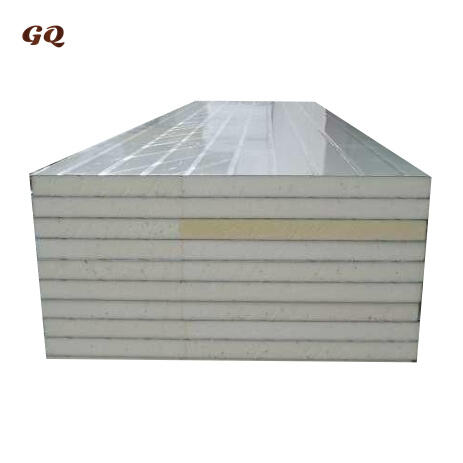بائیکسٹر وال پینلز میں تھرمول انسلیشن کو سمجھیں
بیرونی دیوار پینلز ہر عمارت کے توانائی شاٹل کو بہتر بنانے اور HVAC توانائی استعمال کو کم کرنے میں حیاتی ہیں۔ گرمی کا منتقلہ جاتا ہوا ختم ہو جاتا ہے، جس کے نتیجے میں انڈور فضاؤں میں زیادہ ثابت حالات پیدا ہوتے ہیں، جن کے لیے کم گرما یا سردی کی ضرورت ہوتی ہے۔ یہ معنا رکھتا ہے کہ توانائی کے استعمال اور وسائل کے خرچ میں محسوس کمی اور سال بھر کی آرام داری، باہری درجات حرارت کے بھی بغیر۔
مندرجہ ذیل دیٹا نے بہترین گرما کی عایش کی مدد کرتے ہوئے انرژی کی بچت کے اثر کو ثابت کر لیا ہے۔ مثال کے طور پر، عمارات میں عایش کی بہتری کی بنیاد پر 15 فیصد انرژی کی استعمال کی بچت ہوسکتی ہے اور اس طرح کربن فوٹ پرنٹ اور انرژی کے خرچ میں درامد کٹاؤ ہوسکتا ہے۔ ہوا کی جھڑیوں اور گرم اور سرد مقامات کو روکتے ہوئے، پینلز کمفورٹ اور رہائش کو بہتر بناتے ہیں، گرما کی عایش کی بنیاد پر باہری دیواروں کے نظام کا کردار زیادہ ظاہر کرتے ہیں۔
بہار کی دیوار پینل نظام کیسے کام کرتے ہیں
عایش کے نظام کے مکمل حصے
ایسی سیستمز جیسے External Insulating and Finishing Systems (EIFS)، ماحول ہیں جو البتہ کام کرتے ہیں تاکہ کفایتمند حرارتی برداری فراہم کر سکیں۔ یہ ماحول - جیسے expanded polystyrene (EPS) یا mineral wool کی طبقہ، ایک ڈرینیج پلین، اور کلاڈنگ - کام کرتے ہیں تاکہ گرمی کے منتقلہ کو کم کر سکیں اور ایک عمارت کی آرام داری اور توانائی کارآمدی میں بہتری آئے۔ مویشی گرمی کو روکنے کے لیے پروٹیکٹیو برائرز، جیسے fiberglass mesh سے بنے، بھی کام کرتے ہیں، جو strain resistance میں مدد کرتے ہیں۔
"معماری اور ڈزائن" جریدے میں شامل مطالعات ظاہر کرتی ہیں کہ یہ سسٹم توانائی کی کفایت میں معنوی طور پر اضافہ کرتے ہیں، ASHRAE 90.1 جیسے معیاروں کو پورا کرتے ہوئے۔
مستقل عایق اور حرارتی برجیںگ کم کرنا
مسلسل عایش کمیٹن ترمو برجینگ کو کم سے کم کرتی ہے، جو عام طور پر انرژی کی ناکارداری ہوتی ہے۔ اس طریقے سے باہری دیوار پر ایک منظم لیئر فراہم کیا جاتا ہے، گرمی کے ڈھونڈنے والے نقاط کو ختم کرتے ہوئے۔ ترمو برجینگ کو کم کرنے سے، باہری دیوار پینلز انرژی کی بچت اور آرام کو ماکسimum کرتی ہیں، جو وسیع صنعتی تحقیق کے ذریعے ثابت کیا گیا ہے۔
مثال کے طور پر، EIFS مسلسل عایش کے ساتھ ہر انچ پر 4 سے 5.6 کا R-value دکھاتا ہے، جو ربطہ طریقے سے مطابقت رکھنے والے معاملات کی نسبت زیادہ بچت دکھاتا ہے۔ معاملات کی تحقیقات مسلسل عایش کی کارکردگی کو حديث کلاڈنگ سسٹمز میں ثابت کرتی ہیں۔
متریل کمپیریسن: EIFS vs. Insulated Metal Panels
EIFS (Exterior Insulation and Finish Systems) کے فائدے
ایف ایس ایف کئی فوائد پیش کرتے ہیں، جن میں لاگت کے لحاظ سے موثر ہونا، حرارتی کارآمدی اور ڈزائن کی ورجنٹی شامل ہے۔ یہ نظام عالی حرارتی کارکردگی فراہم کرتے ہیں، جس کے باعث ان کی توانائی کو کم کرنے کے لئے مشہور ہوتے ہیں۔ ایک اہم فائدہ یہ ہے کہ اس کی مرطوبی کی تدبر کی صلاحیت ہوتی ہے، جو ٹھوس پانی کے مسئلے سے بچانے اور عمارات کی ساخت کی ثبات کو حفظ کرتے ہوئے اندر کی آرام دہی کو یقینی بناتی ہے۔
تحقیق نے ایف ایس ایف کی مختلف ابتداء کے تحت اقلیمیں میں ان کی کارآمدی کو ثابت کیا ہے۔
ترکیبی میٹل پینلز کی محدودیتیں
ترکیبی میٹل پینلز، جبکہ قابل اعتماد اور خوبصورتی کے لحاظ سے مقبول ہوتے ہیں، حرارتی رسانی اور عایش میں چیلنجز پیش کرتے ہیں۔ وہ حرارتی پل کے طور پر کام کر سکتے ہیں، جو گرمی کی منتقلی کو بڑھاتے ہیں اور عایش والے اختیارات کے مقابلے میں انرژی کارآمدی کو کم کرتے ہیں۔
خبيرین کی رائے میں طویل مدت تک کارکردگی کے مسائل کی شناخت ہے، خاص طور پر انرژی کارآمدی کو حفظ کرنے میں۔ مطالعات بڑھتے چلے کیا عملی لاگت، اس کی ضرورت کو ظاہر کرتی ہے کہ مستقل اختیارات کو مناسب انرژی بچاؤ کے لئے سوچا جائے۔
بیرونی پینلز کے لئے حرارتی کارکردگی کی معیاریات
R-Value اور U-Factor کی وضاحت
اینسیولیشن کی کارکردگی کو سوچتے ہوئے R-Value اور U-Factor بہت اہم ہوتے ہیں۔ R-Value ایک ناپ ہے کہ اینسیولیشن حرارت کو کتنی دیر تک روکتا ہے۔ مثلاً، R-19 دیواریں R-11 دیواروں کی در@stop مقابلہ میں زیادہ مقاومت دیتی ہیں۔ U-Factor اور حرارت کا منتقلہ: U-Factor حرارت کی ناپ ہے؛ چھوٹی رقم ہو تو بہتر خصوصیات ہوتی ہیں۔ ان مواد کو منتخب کرنے کی ضرورت ہے جو انرژی کی ضروریات اور ماحولیاتی حالتوں کو مناسب ہوں۔
امریکی انرژی وزارت کlimates zones پر مبنی R-Values کی تجویز کرتی ہے، جس سے متعدد انسیولیشن کے اختیارات کی ضرورت ظاہر ہوتی ہے۔
مواسطہ مقاومت کی تاثرات اینسیولیشن کی لمبی مدت تک کارکردگی پر
میزج کی ممانعت انسولیشن کی کارکردگی اور زندگی کے دوران برقرار رکھنے کے لئے ضروری ہے۔ میزج انسولیشن کو خراب کر سکتا ہے، جس سے حرارتی کارکردگی کم ہو جاتی ہے۔ بہترین طریقے کا تجویز یہ ہے کہ مثبت میزج ممانعت والے مواد کا انتخاب کریں اور حفاظتی پرده کو برقرار رکھیں۔
ماہرین کی رائے میں یہ ہے کہ صحیح میزج کی تدبيرداری باہری دیواروں کے نظام کی عمر کو بڑھا سکتی ہے، اس کی اہمیت کو انسلیشن کے فیصلوں میں زیادہ زور دیتے ہوئے۔
باہری دیواروں کے انسلیشن کے موسمی فوائد
گرما کے موسم میں حرارت کو کم کرنے کی رistrategies
باہری دیواروں کا انسلیشن گرما کے موسم میں حرارت کو کم کرنے میں مدد کرتا ہے اور سازوں کے خرچ کو کم کرتا ہے۔ یہ ایک حرارتی پرде کی طرح کام کرتا ہے، داخلی علاقے کو سرد رکھتا ہے اور ایر کونڈشیننگ پر متاثر نہ ہونے کی وجہ بناتا ہے۔ پاسوی سولر ڈیزائن کے اصول کا تجویز ہے کہ انسلیشن، سایہ اور وینٹیلیشن کے ساتھ، طبیعی آرام کو بہتر بنانا چاہئے۔
ریاستی توانائی کی معلوماتی انتظامیہ کے مطابق، اچھی طرح سے حرارتی روک تھام والے گھروں میں گرمیوں کے توانائی کے اخراجات کو کافی حد تک کم کیا جا سکتا ہے، جس سے موئے کی مالی اور ماحولیاتی فوائد ثابت ہوتے ہیں۔

سردیوں میں گرمی کو رکھنے کی صلاحیت
گرما کو رکھنے کے ذریعے، سکون کو بڑھانے اور گرما کی ضرورت اور توانائی کے بیلز کو کم کرنے میں صاف کاروبار کا موسم سرد میں عایش کی اہمیت بلند ہوتی ہے۔ انرژی کے دپارٹمنٹ کے مطابق معقول صاف کاروبار سے گرمی کے خرچ میں تقریباً 15 فیصد تک کمی ہوسکتی ہے۔
یہ بچت معاشی اور حالاتی فوائد دکھاتی ہے جو کم کردہ فossیل فیول کے استعمال سے متعلق ہیں، جو عالی گرمی سے بچنے والے مواد کے سال بھر کے فوائد دکھاتے ہیں۔
بہترین حرارتی کارآمدی کے لئے ڈیزائن کی ملاحظات
خوبصورتی اور صاف کاروبار کی کارکردگی کو متوازن بنانا
عمارات کے ڈیزائن کے ذریعے خوبصورتی اور حرارتی کارکردگی پر زیادہ تاثیر ہوتی ہے۔ دونوں کو متوازن بنانا انرژی کی کارآمدی کے لئے ضروری ہے جبکہ خوبصورتی کو کم نہیں کیا جانا چاہئے۔ مدرن فیسڈ کے نظام میں مرکب پینلز یا کلاڈنگ کا استعمال کرتے ہوئے ممکن ہے کہ عظیم صاف کاروبار کے ساتھ خوبصورت باہری شکل حاصل ہو۔
معماریں اکثر مواد اور ٹیکسچرز کو مخلوط کرتے ہیں تاکہ بصورتی طور پر دلچسپ ساختیں بنائیں جو حرارتی طور پر بہترین عمل کرتی ہیں، ڈیزائن عنصر کو کام کے ساتھ متوازن بناتے ہوئے بصورتی اور صاف کاروبار کے مقاصد کو پورا کرتے ہیں۔
کوڈ کی مطابقت اور آتش کی سلامتی کی معیار
بیرونی پینل کے لئے گرما معاین کی انتخاب کرتے وقت عمارات کے معاہدے اور آگ کی حفاظت کی معیار پر عمل کرنा ضروری ہے۔ یہ ضوابط یقینی بناتے ہیں کہ مواد انرژی فوائد دینے کے ساتھ ساتھ حفاظت کے معیار بھی پورا کرتے ہیں۔ ماہرین کی مشورت کرتے ہوئے آگ کے مقابلے میں جانچے گئے مواد کا انتخاب کریں، یہ یقینی بناتا ہے کہ صلاحیتوں کے ساتھ ساتھ کارکردگی کے مقاصد بھی پورے ہوتے ہیں۔
محترفہ رہنمائی کی مدد سے یہ ضرورتیں نیگرانی کی جا سکتی ہیں، جس سے جگہیں حفاظت کے ساتھ ساتھ انرژی کارکردگی پر محیط ہوتی ہیں۔ ڈزائن کو ضرورتیں سے ملانا حفاظت کی یقینیت کے ساتھ گرمی کارکردگی والے عمارات کا باعث بنتا ہے۔
اکثر پوچھے جانے والے سوالات کا سیکشن
بیرونی دیوار پینل میں گرما معاین کیوں اہم ہے؟
بیرونی دیوار پینل میں گرما معاین گرما منتقلی کو کم کرنے، منظم درجہ حرارت کو برقرار رکھنے اور انرژی کارکردگی کو بہتر بنانے کے لئے ضروری ہے۔ یہ انرژی کی بچत کی طرف زیریں، کم یونیٹی کی لاگت اور عمارات کے اندر کمfort سطح کو بڑھاتا ہے۔
معاین شدہ کلاڈنگ نظام میں کیا مواد استعمال ہوتے ہیں؟
اینسیوٹڈ کلیڈنگ سسٹمز معمولی طور پر ایکسپینڈ ڈ پالی سٹائرین، مینرل وول، شیتھنگ، اور بارے آؤٹ سائیڈ فیسیڈز جیسے مواد کا استعمال کرتے ہیں تاکہ گرمی کی منتقلی کو کم کیا جا سکے اور سکون اور انرژی کی کفایت میں 개선 کیا جا سکے۔
سلسلہ وار عایش کیسے کام کرتا ہے؟
سلسلہ وار عایش باہری دیوار پر ایک منظم لیئر فراہم کرتا ہے، جس سے گرمی کی چھوٹی ہو جاتی ہے کہاں نکل سکتی ہے۔ یہ حرارتی برجینگ کو کم کرتا ہے اور انرژی کی بچत اور سکون میں دریافت کرتا ہے۔
EIFS میٹل پینلز کے مقابلے میں کیا فائدے ہیں؟
EIFS میٹل پینلز کیلئے بہتر حرارتی عمل، مویستی کی مدیریت، اور مختلف ماحولات میں مروبطی فراہم کرتا ہے، جبکہ میٹل پینلز گرمی کی منتقلی کو کم کرنے میں کم کارکردگی رکھتے ہیں۔
R-Value اور U-Factor کے درمیان کیا فرق ہے؟
R-Value حرارتی مقاومت کو پیمانہ کرتا ہے، جس میں زیادہ قدر اچھی عایش کی نشاندہی کرتی ہے۔ U-Factor گرمی کی منتقلی کی شرح کو پیمانہ کرتا ہے، جس میں کم قدر اچھی عایش کی خصوصیات کی نشاندہی کرتی ہے۔
مندرجات
- بائیکسٹر وال پینلز میں تھرمول انسلیشن کو سمجھیں
- بہار کی دیوار پینل نظام کیسے کام کرتے ہیں
- متریل کمپیریسن: EIFS vs. Insulated Metal Panels
- بیرونی پینلز کے لئے حرارتی کارکردگی کی معیاریات
- باہری دیواروں کے انسلیشن کے موسمی فوائد
- بہترین حرارتی کارآمدی کے لئے ڈیزائن کی ملاحظات
- اکثر پوچھے جانے والے سوالات کا سیکشن

 EN
EN







































